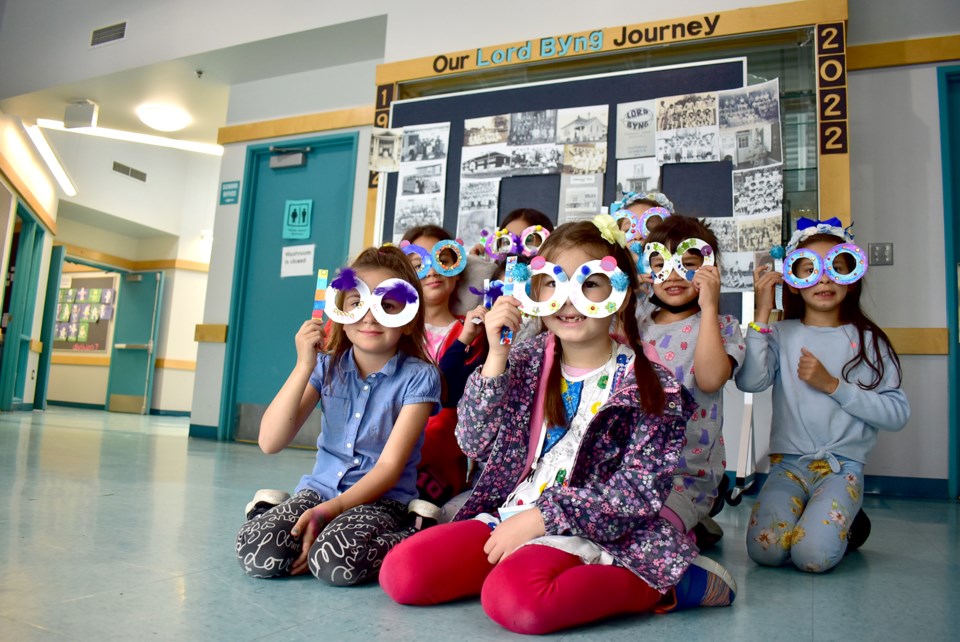It’s been a hundred years since Byng elementary was named after Field Marshall Julian Hedworth George Byng, a Canadian hero of the First World War and later Governor-General of Canada.
The school just celebrated this milestone, but the current Byng elementary school wasn’t the first school – or first name for the school – on this site.
While much of the celebrations includes material things – pins, coloured glasses, displays with photos and mementos - creating a sense of belonging to the school and its history is a big part of the celebration.
Helen Sipsas, who has taught at the school for more than three decades, has been thinking about the 100-year anniversary for months, hoping to inspire her students to feel connected to the history of the school, especially after two years of COVID-19 restrictions that have disrupted so many normal activities.
“Learning about our history gives us a sense of our connection to place,” Sipsas said. “(It’s) where we interact to learn, we create memories, we reflect on history, we connect with culture and then we can establish identity.”
Given the effects of the pandemic on daily life at school, Sipsas feels it’s especially important to make the students feel like they belong to the school community.
“Covid has taken a real hit for all of us – we’re doing things for the first time in a long time, sports day, track meet, and we’ve lost a little bit of that,” she said, adding “Now we’re slowly coming back, to building community and camaraderie because we lost that a little bit.”
In 1897, the first school was built on the site - Steveston elementary was established as a one-room school house, later expanding to two rooms.
In 1922, as the “Great War” was fresh in the minds of Canadians and Richmondites, the school was named after Lord Byng, a commander in the Canadian army at the end of the war, who led the Canadian army to victory at the Battle of Vimy Ridge.
In 1930, as the Steveston community was growing, a 14-room school was built to replace the two-room school.
But a fire damaged parts of the school in 1946, and for two years, students attended in shifts. It was finally rebuilt in 1948, but continued to need more space, and in 1959, the school was further expanded.
This school would endure for another 35 years, until the current school was built in 1995.
Sipsas has been part of the planning committee for the 100th anniversary celebration, and it has become her passion project.
Leading up the centennial, she’s been talking with her Grade 1 and 2 students about the history of the school, even the difficult parts.
In 1942, the Byng school population was decimated as all local Japanese families – as well as thousands from across B.C. – were ordered into internment camps as Japan and Canada were at war.
As Sipsas explained to her students, many of the students from Byng elementary were gone.
Steveston resident and Japanese descendent Kelvin Higo told the class how adults could only take 150 pounds of personal belongings along as they were shipped to internment camps, and children could only take 75 pounds.
These are the “difficult” parts of history, Sipsas told the Richmond News, but she’s impressed by how her young students can handle difficult issues.
While the school is named after a man, Sipsas also wanted her students to learn about two significant women of Japanese descent who were part of Byng elementary’s history.
Hide Hyodo is perhaps the best known. Hyodo lived in Vancouver, but she was brought to Byng elementary to help teach Japanese students, although her Japanese was minimal.
She kept teaching at Byng even as evacuations were being planned. Toward the end, she taught at Byng during the day, and then took the tram to Hastings Park to help organize the education of students who were waiting there to be interned, and still had to get home by curfew at 9 p.m.
Finally, Hyodo was sent to the Interior along with thousands of other people of Japanese descent. While in the Interior, she was put in charge overseeing seven internment camp schools.
Another staff member of Japanese descent was June Chiba, who was principal of Byng elementary.
Since her death in 1991, the school has been giving out the June Chiba Humanitarian Award to one or two graduating students.
The board of education is planning to update its policy on naming school district facilities, and Higo has suggested Byng be renamed after Hyodo.
Even though she’s taught at the school for more than 30 years, Sipsas said she isn’t against renaming the school, but when she first heard the suggestion, she said she hoped it wouldn’t be this year, given the 100th anniversary of the school being named after Lord Byng.
Three trees have been saved on the school grounds from the school’s early days – two big fir trees and an oak tree, planted in 1907 on Arbor Days.
For Sipsas, these trees represent the deep history of the community of Steveston and Byng elementary.
“Maybe things changed around us… but some things have remained the same and those are the roots,” Sipsas said. “The roots (are) down deep. The trees are there. We are here.”



